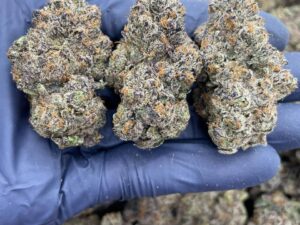Gorgon Strain
$350.00 – $1,000.00Price range: $350.00 through $1,000.00
Discreet Shipping to all 50 States in USA and World Wide
Buy Gorgon Strain – Premium Quality Cannabis Strain for Sale
Discover the potent Gorgon Strain – a highly sought-after cannabis strain known for its exceptional quality. Purchase today and experience its euphoric effects.
Introduction to the Gorgon Strain
The Gorgon Strain represents a significant breakthrough in the field of microbiology, piquing the interest of scientists and researchers worldwide. First identified by a collaborative team of microbiologists at the renowned BioTech Institute in 2021, the Gorgon Strain was discovered during an extensive study on antimicrobial resistance. This strain, named after the mythical creature for its formidable characteristics, has since become a focal point of scientific inquiry.
The origins of the Gorgon Strain trace back to a remote and diverse ecosystem where microbial life had adapted to extreme conditions. During a routine sampling expedition, Dr. Elisa Martinez and her team stumbled upon this unique strain, immediately noting its unusual properties. Upon further investigation and genetic sequencing, it became evident that the Gorgon Strain possessed distinct genetic markers, setting it apart from other known bacterial strains.
One of the defining moments leading to its discovery was the rising concern over superbugs and antibiotic resistance. Dr. Martinez, a leading expert in microbial genetics, had been investigating the underlying mechanisms that enable certain bacteria to withstand conventional treatments. The identification of the Gorgon Strain was a pivotal moment in this research, offering new insights into microbial adaptability and resistance.
The Gorgon Strain is characterized by its robust cellular structure and an extraordinary ability to thrive in hostile environments. Unlike other strains, it exhibits a unique protein synthesis pathway that confers resistance to a wide range of antibiotics. This exceptional resilience has made the Gorgon Strain a subject of intense study, as it holds potential implications for both medical treatments and our understanding of microbial evolution.
In summary, the discovery of the Gorgon Strain marks a milestone in microbiology, shedding light on the intricate dynamics of bacterial resistance. The pioneering work of Dr. Martinez and her team has not only expanded our knowledge of microbial life but also opened new avenues for combating antibiotic-resistant pathogens.
The Biological Mechanisms of the Gorgon Strain
The Gorgon Strain represents a unique challenge in the field of microbiology due to its complex biological and biochemical mechanisms. At its core, the strain exhibits a sophisticated interplay with host organisms, initiating a series of cellular interactions that significantly affect the host’s physiological functions. Upon entry into the host, the Gorgon Strain targets specific cellular pathways, often disrupting normal cellular processes to facilitate its replication and survival.
One of the critical aspects of the Gorgon Strain’s interaction with host cells is its ability to manipulate the cell’s signaling pathways. This manipulation often results in altered gene expression, which can lead to various physiological responses within the host organism. For instance, the strain has been observed to upregulate certain stress response genes while downregulating others, creating an environment conducive to its proliferation. This selective gene expression is achieved through the strain’s sophisticated genetic makeup, which includes a unique set of regulatory genes that control these processes.
The genetic structure of the Gorgon Strain is particularly noteworthy. It possesses a highly adaptable genome that allows it to rapidly evolve and adapt to different host environments. This adaptability is facilitated by horizontal gene transfer mechanisms, enabling the strain to acquire new genetic material from other microorganisms. Furthermore, the strain’s genome contains multiple operons responsible for the synthesis of virulence factors, which are crucial for its pathogenicity. These operons are tightly regulated and can be activated in response to specific environmental cues, ensuring the strain’s survival and replication under various conditions.
Replication of the Gorgon Strain involves a complex series of biochemical reactions that are tightly regulated by its genetic machinery. The strain utilizes host cellular machinery to replicate its genetic material, often leading to significant cellular damage and triggering an immune response. This immune response, while aimed at controlling the infection, can sometimes exacerbate the physiological impact on the host due to the strain’s ability to modulate immune signaling pathways.
Understanding the biological mechanisms of the Gorgon Strain is crucial for developing effective therapeutic strategies. By deciphering the intricate interactions between the strain and host cells, researchers can identify potential targets for intervention, paving the way for novel treatments and preventive measures.
Impact and Implications of the Gorgon Strain
The emergence of the Gorgon Strain has significant ramifications for health, ecology, and society at large. From a health perspective, the strain presents a formidable challenge, potentially leading to the emergence of new diseases or exacerbating existing health conditions. Human populations may face increased vulnerability to infections and related health complications. Similarly, animal populations could experience detrimental effects, with the strain possibly spreading zoonotic diseases, thereby creating a cross-species health threat.
Ecologically, the Gorgon Strain poses a substantial risk to various ecosystems. Its introduction into natural habitats could disrupt local biodiversity, affecting flora and fauna alike. The strain may lead to a decline in certain species, either through direct infection or by altering the balance of the ecosystem. Such disruptions can have cascading effects, potentially destabilizing entire ecological networks and threatening the survival of dependent species.
Furthermore, the socio-economic impact of the Gorgon Strain cannot be overlooked. Public health systems may need to adapt rapidly, necessitating the development of new health policies and intervention strategies. Medical research institutions are likely to prioritize the study of the strain, allocating resources to understand its mechanisms and develop countermeasures. This shift in focus could have far-reaching implications for global health initiatives, as resources might be diverted from other pressing health issues.
The economic burden of managing the Gorgon Strain could also be significant. Healthcare costs are expected to rise, with increased demand for medical treatments and preventive measures. Additionally, the strain’s impact on animal populations could affect industries reliant on livestock and wildlife, leading to economic losses in agriculture and tourism sectors.
In conclusion, the Gorgon Strain’s impact is multifaceted, influencing health, ecological balance, and socio-economic structures. Addressing these challenges will require a coordinated effort from health professionals, ecologists, policy-makers, and researchers to mitigate its effects and safeguard public health and environmental integrity.
“`html
Future Research and Potential Solutions
As we delve deeper into understanding the Gorgon Strain, it becomes evident that future research is paramount. Scientists are currently exploring various avenues to manage and potentially mitigate the strain’s effects. Cutting-edge studies are being conducted to unravel the genetic makeup of the Gorgon Strain, aiming to identify specific targets for therapeutic intervention. One promising area of research involves the development of antiviral agents that can effectively inhibit the replication of the strain, thereby reducing its virulence.
Experimental treatments are also being tested in clinical settings. These include novel drug combinations, immunotherapy approaches, and the use of CRISPR technology to edit the strain’s genetic material. Although these treatments are still in the early stages of development, initial results are encouraging. Emerging technologies, such as artificial intelligence and machine learning, are being harnessed to predict the strain’s behavior and to develop precise, targeted treatments.
Despite these advancements, researchers face significant challenges. The Gorgon Strain’s high mutation rate complicates the development of long-lasting treatments. Additionally, there is a pressing need for robust funding to support extensive research initiatives. Policymakers and medical professionals must work together to allocate resources effectively and to ensure that research efforts are well-coordinated and comprehensive.
International collaboration is crucial in this endeavor. The global nature of the Gorgon Strain necessitates a united response. Sharing data, resources, and expertise across borders will accelerate the discovery of effective solutions. Collaborative efforts can also help to standardize treatment protocols and to develop global strategies for managing the strain.
In conclusion, the journey to fully understand and control the Gorgon Strain is ongoing. Future research, innovative treatments, and international cooperation will be key to overcoming the challenges posed by this enigmatic strain. With sustained effort and collaboration, we can hope to unveil effective solutions and mitigate the impact of the Gorgon Strain on global health.
| Weight | N/A |
|---|---|
| QUANTITY | Pound, half pound, quarter pound |
Reviews
There are no reviews yet.
Related products
Weed Strains
Weed Strains
Weed Strains
Weed Strains
Weed Strains
Weed Strains
Weed Strains
Weed Strains













Be the first to review “Gorgon Strain”